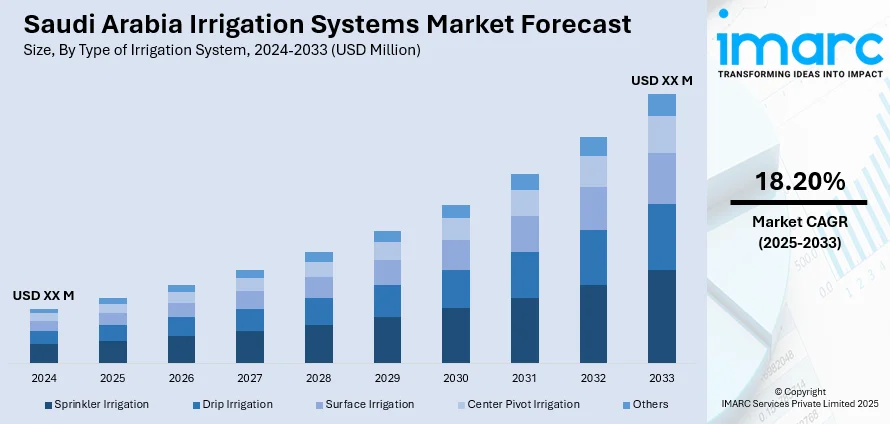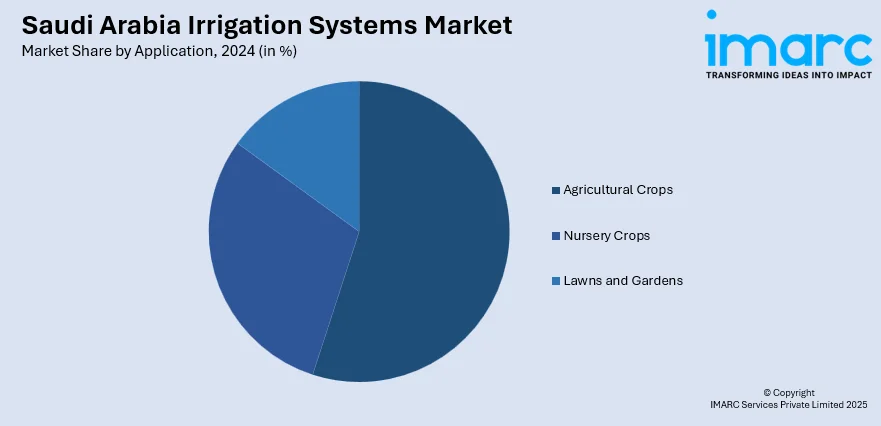
Saudi Arabia Irrigation Systems Market Size, Share, Trends and Forecast by Type of Irrigation System, Crop Type, Application, and Region, 2025-2033
Saudi Arabia Irrigation Systems Market Overview:
The Saudi Arabia irrigation systems market size is exhibiting a growth rate (CAGR) of 18.20% during 2025-2033. The market is driven by the nation's commitment to sustainable agriculture and water conservation. Government initiatives, such as subsidies and collaborations with international organizations, are promoting the adoption of advanced irrigation technologies like drip and sprinkler systems. The integration of smart technologies, including sensors and automation, enhances water-use efficiency and crop yields. These positive developments are strengthening the competitive landscape and expanding the Saudi Arabia irrigation systems market share.
|
Report Attribute
|
Key Statistics
|
|---|---|
|
Base Year
|
2024 |
|
Forecast Years
|
2025-2033
|
|
Historical Years
|
2019-2024
|
| Market Growth Rate 2025-2033 | 18.20% |
Saudi Arabia Irrigation Systems Market Trends:
Government Initiatives and Vision 2030
Saudi Arabia’s Vision 2030 initiative is a strategic driver for transforming agriculture through sustainability and innovation. Under this framework, the government actively supports the adoption of modern irrigation systems by providing financial incentives, grants, and technical support to farmers. Institutions such as the Ministry of Environment, Water, and Agriculture have implemented policies to enhance irrigation systems and decrease water usage. Public-private collaborations and partnerships with international agritech companies further support these initiatives. National campaigns also focus on water conservation and support the application of precision irrigation equipment. These are not only effective in saving water resources that are scarce but also support economic diversification through enhanced domestic agricultural production. Together, Vision 2030 and other government actions rapidly spur Saudi Arabia's irrigation systems market modernization and growth.

To get more information on this market, Request Sample
Technological Advancements in Irrigation Systems
The rapid adoption of smart irrigation technologies is a major force shaping Saudi Arabia’s agricultural sector. Technologies like Internet of Things (IoT)-capable controllers, live weather-based automation, and soil moisture sensors are being adopted in farms to improve water usage. These setups enable farmers to have perfect control over irrigation timings to prevent wastage and increase crop yields. Moreover, cloud-based farm management platforms provide farmers with data regarding field conditions, water needs, and irrigation efficiency. Such tools are highly useful for large-scale desert agriculture projects, where accuracy matters a lot. Supported by government funding and a tech-friendly regulatory environment, these advancements are not only improving operational efficiency but also supporting national water conservation goals. The increasing reliance on data-driven irrigation systems is driving the Saudi Arabia irrigation systems market growth.
Rising Demand for Agricultural Productivity and Food Security
With its growing population and high dependency on food imports, Saudi Arabia faces increasing pressure to improve agricultural productivity. To achieve greater self-sufficiency, the government is encouraging the expansion of domestic food production through efficient resource use. Modern irrigation systems help address this goal by enabling year-round farming and higher crop yields with minimal water input. These systems are especially crucial in arid zones where water access is limited but agricultural expansion is targeted. By optimizing water distribution and supporting diverse crop cultivation, efficient irrigation strengthens food security while reducing environmental impact. Government-backed programs and private sector investment further accelerate the adoption of these systems, making irrigation a cornerstone of Saudi Arabia’s strategy to enhance local food production and reduce import reliance.
Saudi Arabia Irrigation Systems Market Segmentation:
IMARC Group provides an analysis of the key trends in each segment of the market, along with forecasts at the country and regional levels for 2025-2033. Our report has categorized the market based on type of irrigation system, crop type, and application.
Type of Irrigation System Insights:
- Sprinkler Irrigation
- Drip Irrigation
- Surface Irrigation
- Center Pivot Irrigation
- Others
The report has provided a detailed breakup and analysis of the market based on the type of irrigation system. This includes sprinkler irrigation, drip irrigation, surface irrigation, center pivot irrigation, and others.
Crop Type Insights:
- Cereals and Grains
- Fruits and Vegetables
- Oilseeds and Pulses
- Cash Crops
A detailed breakup and analysis of the market based on the crop type have also been provided in the report. This includes cereals and grains, fruits and vegetables, oilseeds and pulses, and cash crops.
Application Insights:

- Agricultural Crops
- Nursery Crops
- Lawns and Gardens
A detailed breakup and analysis of the market based on the application have also been provided in the report. This includes agricultural crops, nursery crops, and lawns and gardens.
Regional Insights:
- Northern and Central Region
- Western Region
- Eastern Region
- Southern Region
The report has also provided a comprehensive analysis of all the major regional markets, which include the Northern and Central Region, Western Region, Eastern Region, and Southern Region.
Competitive Landscape:
The market research report has also provided a comprehensive analysis of the competitive landscape. Competitive analysis such as market structure, key player positioning, top winning strategies, competitive dashboard, and company evaluation quadrant has been covered in the report. Also, detailed profiles of all major companies have been provided.
Saudi Arabia Irrigation Systems Market News:
- In April 2025, the Kingdom of Saudi Arabia's Food and Agriculture Organization (FAO) and the Saudi Irrigation Organization (SIO) partnered to launch the second intensive training program, which aims to give lead farmers advanced skills in managing and operating modern irrigation technologies.
Saudi Arabia Irrigation Systems Market Report Coverage:
| Report Features | Details |
|---|---|
| Base Year of the Analysis | 2024 |
| Historical Period | 2019-2024 |
| Forecast Period | 2025-2033 |
| Units | Million USD |
| Scope of the Report |
Exploration of Historical Trends and Market Outlook, Industry Catalysts and Challenges, Segment-Wise Historical and Future Market Assessment:
|
| Type of Irrigation Systems Covered | Sprinkler Irrigation, Drip Irrigation, Surface Irrigation, Center Pivot Irrigation, Others |
| Crop Types Covered | Cereals and Grains, Fruits and Vegetables, Oilseeds and Pulses, Cash Crops |
| Applications Covered | Agricultural Crops, Nursery Crops, Lawns and Gardens |
| Regions Covered | Northern and Central Region, Western Region, Eastern Region, Southern Region |
| Customization Scope | 10% Free Customization |
| Post-Sale Analyst Support | 10-12 Weeks |
| Delivery Format | PDF and Excel through Email (We can also provide the editable version of the report in PPT/Word format on special request) |
Key Questions Answered in This Report:
- How has the Saudi Arabia irrigation systems market performed so far and how will it perform in the coming years?
- What is the breakup of the Saudi Arabia irrigation systems market on the basis of the type of irrigation system?
- What is the breakup of the Saudi Arabia irrigation systems market on the basis of crop type?
- What is the breakup of the Saudi Arabia irrigation systems market on the basis of application?
- What is the breakup of the Saudi Arabia irrigation systems market on the basis of region?
- What are the various stages in the value chain of the Saudi Arabia irrigation systems market?
- What are the key driving factors and challenges in the Saudi Arabia irrigation systems market?
- What is the structure of the Saudi Arabia irrigation systems market and who are the key players?
- What is the degree of competition in the Saudi Arabia irrigation systems market?
Key Benefits for Stakeholders:
- IMARC’s industry report offers a comprehensive quantitative analysis of various market segments, historical and current market trends, market forecasts, and dynamics of the Saudi Arabia irrigation systems market from 2019-2033.
- The research report provides the latest information on the market drivers, challenges, and opportunities in the Saudi Arabia irrigation systems market.
- Porter's five forces analysis assist stakeholders in assessing the impact of new entrants, competitive rivalry, supplier power, buyer power, and the threat of substitution. It helps stakeholders to analyze the level of competition within the Saudi Arabia irrigation systems industry and its attractiveness.
- Competitive landscape allows stakeholders to understand their competitive environment and provides an insight into the current positions of key players in the market.
Need more help?
- Speak to our experienced analysts for insights on the current market scenarios.
- Include additional segments and countries to customize the report as per your requirement.
- Gain an unparalleled competitive advantage in your domain by understanding how to utilize the report and positively impacting your operations and revenue.
- For further assistance, please connect with our analysts.
 Request Customization
Request Customization
 Speak to an Analyst
Speak to an Analyst
 Request Brochure
Request Brochure
 Inquire Before Buying
Inquire Before Buying




.webp)




.webp)












